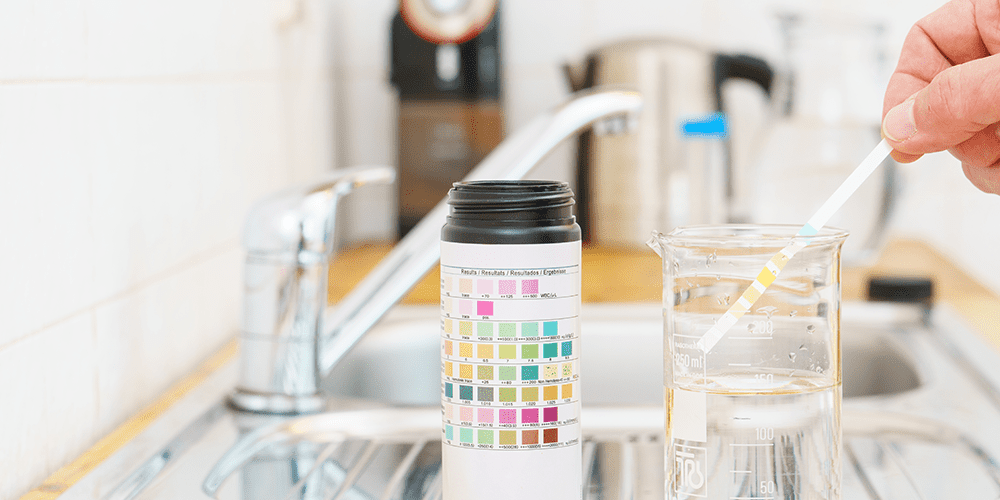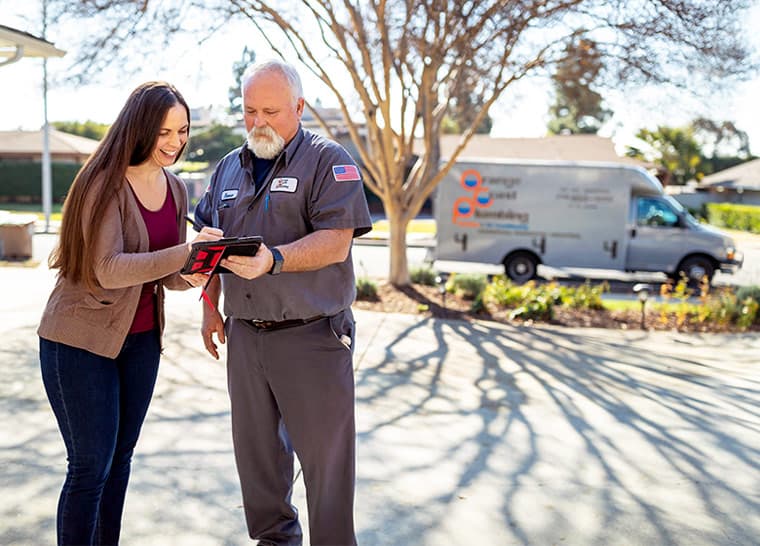Most homes in the United States connect to a municipal water system.
Cities collect water and treat it before sending it to your home. We trust treatment plants to remove harmful bacteria and other contaminants.
But some municipal water treatment facilities fall short of the standards we expect. And even when they meet standards, municipal water travels long before reaching your tap.
Treated water sits in reservoirs, runs through pipes at the plant, enters the main supply line, and flows through your home’s pipes. There’s potential for contamination at every step.
There’s nothing to worry about in most cases, but you should test your water if you notice the problems listed below.
Your municipal water may be contaminated. More likely, the contamination comes from somewhere in your plumbing.
How to Test Your Water with a Testing Kit
Home improvement stores and online retailers sell inexpensive water-testing kits that measure chemical components like heavy metals (lead and arsenic), pH levels, and chlorine or other disinfectants used by treatment facilities. Some tests may check for bacteria and viruses in the water sample.
If your DIY water test suggests a problem with water in your home, the next step is to bring in a certified plumber to conduct more advanced tests and to look for the source of the problem. The solution may involve a simple repair, a partial repiping, or a call to your city water department. But only a plumber can point you in the right direction.
These are the things to look for before testing your water and ultimately calling the plumber for further inspection.
1. Your Water Looks Cloudy
You fill a glass with water and hold it up to the light. It should look crystal clear.
Ruling out the possibility that the glass has a layer of detergent film, cloudiness may mean that your home’s pipes (or municipal pipes) are corroding. Healthy water contains minerals, but mineral content shouldn’t affect the clarity of your water.
2. Your Water Smells Like Chlorine
Drinking water should be odorless. While water can taste different from city to city (and smell different to a dog’s sensitive nose), strong odors signify that something has gone wrong.
Chlorine smells are particularly problematic. Treatment facilities add chlorine to the water to kill bacteria, but not enough to produce a strong odor.
Chlorine is dangerous to your health in high concentrations. If your water smells like a municipal swimming pool and not the municipal water supply, test it.
3. Your Water Has Color to It (Brown, Orange, Yellow)
Water should be 100% clear. Any water with a tinge of color merits testing.
Brown and orange are typically indications of rust — corroded pipes or faucets — and while rusty water isn’t dangerous to most people, you’ll want to call the plumber for further testing and potential repair.
Yellow is more common in hot water, tracing to a bacterial infestation in your water tank. A plumber will need to flush and chemically treat the tank.
Another approach is to temporarily raise the water temperature in the tank above 160 degrees to kill the bacteria. Still, since the safe upper limit for water heaters is 120 degrees, we don’t recommend this DIY fix. Hire a plumber instead.
4. Your Water Smells Like Sulfur
Sulfur has a pungent and unmistakable odor. “It smells like hell!” — or, more likely, rotten eggs.
Most water supplies have it in trace amounts of sulfur, but not enough for a human nose to detect.
Drinking water with a high sulfur content is dangerous. It builds up in the body and can cause intestinal problems and dehydration.
Cold water sulfur smells are uncommon. Hot water sulfur odors point to the same sulfur bacteria infestation in your water tank that is turning water yellow.
5. You Have Corroded Pipes
If you have deteriorating pipes, especially those running underneath the house, there’s a high probability your water is contaminated.
Corroded pipes can leach chemicals or allow outside contaminants to seep into your water supply. If this information isn’t enough to spur you to action, consider the prospect of returning home to a flood — a common scenario with a slab leak in your foundation.
A plumber can reline pipes with epoxy if they’re not too far gone. It’s cheaper than repiping badly corroded pipes and better for your drinking water supply.
6. You & Your Family Are Experiencing Physical Distress
Your water may be suspect if you have any new or long-lasting physical symptoms.
What symptoms, exactly? Itchy skin, rashes, dry hair, nausea, vomiting, and abdominal pain, among others.
Does your water have a metallic taste? Test it.
And if your tests suggest something’s amiss, have a plumber confirm your findings and recommend a course of action to restore the quality of your water supply.
FAQs: Testing Your Drinking Water
Q: What are some signs of poor water quality?
Signs include a strange taste or odor, discoloration, sediment, and corrosion of pipes and fixtures.
Q: Can I test my drinking water at home?
DIY water testing kits can detect the presence of contaminants like lead, chlorine, nitrates, and bacteria. These tests are simple and provide immediate results but are less comprehensive than professional tests.
Q: What should I do if my DIY test detects contaminants?
Stop drinking the water immediately, and contact a professional for a more comprehensive analysis or a plumber for repair.
Q: How often should I test my drinking water?
We advise testing your drinking water once a year. However, if you notice any changes in taste, color, or smell, or if there has been recent industrial or agricultural development nearby, your water may need more frequent testing.
Q: What contaminants should I test for in my drinking water?
You should test for common contaminants like lead, chlorine, nitrates, sulfates, bacteria, and viruses. Depending on your location, you might also need to test for specific regional contaminants like arsenic or radon.
Q: Who can professionally test my drinking water?
Certified laboratories and local water authorities have the expertise and equipment to conduct comprehensive water tests. They can provide a detailed analysis of your water quality.
Q: What are the most common water pollutants?
The most common water pollutants include lead, bacteria (E.coli), nitrates/nitrites, chlorine, and heavy metals, all of which can lead to health issues.
Q: How does water become contaminated?
It can become contaminated through agricultural runoff, industrial discharge, outdated plumbing systems, and natural occurrences like flooding.
Q: Can boiling my water make it safe to drink?
Boiling water can kill bacteria and viruses, but it doesn’t remove chemical contaminants like lead or chlorine. It’s not a complete solution for contaminated water.
Q: What can be done to improve drinking water quality?
Regular testing, proper maintenance of plumbing systems, and implementing water treatment methods like filtration or reverse osmosis can help improve drinking water quality. Also, stay informed about your local water supply and any potential risks.


